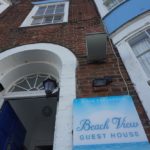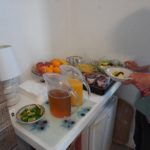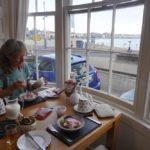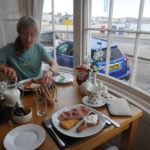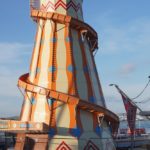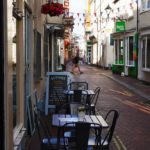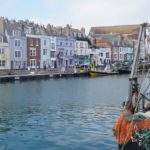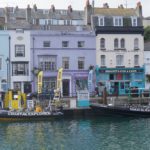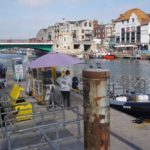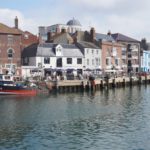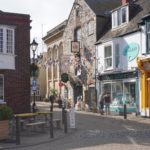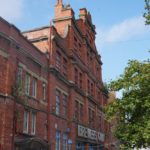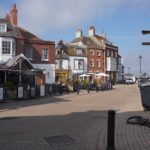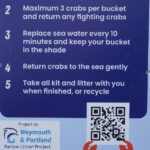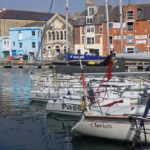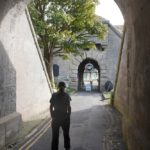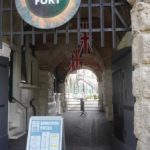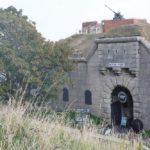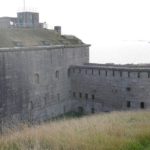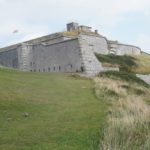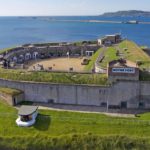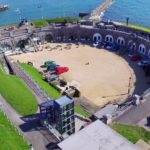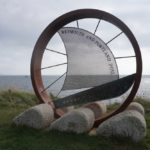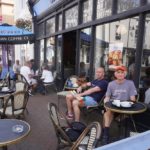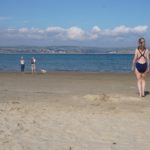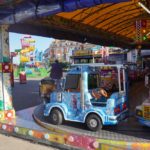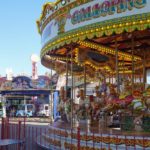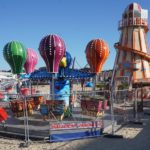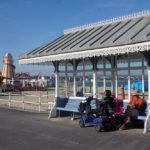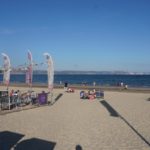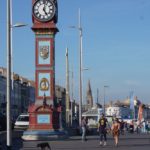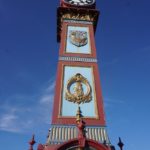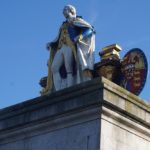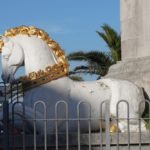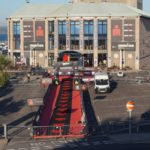Weymouth
A lazy day for us. A recovery day. In 2016 on the Camino Frances we walked 800km in 32 days, an average of 25 km/day. We had 4 or 5 days when we did 30-32 kms. Now seven years later we are walking 240kms in 15 days at an average of 16km/day. Our longest day was 25km. So we are slowing up as we get older. Not sure how many more of these long distance walks we have in us.
We didn’t leave our room until 10.00am and slowly walked around the harbour and back up to the historic Nothe Fort on the headland. The fort is a coastal defence built between 1860 and 1872 by the Royal Engineers. The fort was abandoned by the military in 1956 and purchased by the local council to become a visitor attraction.
Weymouth was known as “England’s Bay of Naples”. What is known today as Weymouth, the beach and town centre, is in fact Melcombe Regis. They were once two separate places, their boundary being the harbour, with Weymouth on the south side and Melcombe Regis on the north. There was much feuding between the two and so in 1571, Elizabeth I granted a royal charter to unite them as the borough of Weymouth and Melcombe Regis.
Weymouth has a royal connection in that it was once the favourite holiday destination of King George III and there are plenty of plaques and place names commemorating his visits. They also have a rather gaudy statue of him in Victoria Square. More of him tomorrow. Speaking of Victoria they have a Queen Victoria Jubilee Clock (1887) commemorating her reign.
Melcombe Regis has a claim to fame as the port where the bubonic plague, known as the black death, entered England in 1348. It was brought ashore by the fleas of the black rats from a ship that had come from the continent. The plague had devastating effects on the population of England. It is estimated that at least half the population was wiped out in the two years that it lingered. Those in Dorset were the first to suffer and people fearing that they would catch it moved away, unsuspecting that they too might be carriers of the spread.
There is a River Wey but it is only 12km long and is more of a stream. At the coast it flows into Radpole Lake, now a suburb of Weymouth, and then into Weymouth Harbour. It was an important water source from Roman times. The river was important for milling during the 18th and 19th centuries, when there were five water mills based along it. All five of the millers needed to carefully co-ordinate their activities to ensure a reliable flow of water.
Like most cities on the south coast, Weymouth was heavily bombed during WWII . It featured prominently in the D-Day landings in Normandy with many British and American soldiers having left the shores of England from here. A memorial on the esplanade records that 517,816 troops and 144,093 vehicles embarked at Weymouth between June 1944 and May 1945.
In the afternoon we went for a swim in the warm clear water of Weymouth Beach. I don’t think I have ever seen sea water so clear. The water was very shallow. One of those beaches where you walk out 50 metres and it is mid-calf deep, walk another 50 metres and it is mid-thigh deep, walk a further 50 metres and it is back to knee deep. At that stage you give up and just sit down in the water. The sand is golden and extremely fine. Maybe this is why sand sculptures are a big thing in Weymouth. Professional sand sculptors use sand originating from fluvial deposits (river sand) that has angular grains mixed with a fraction of silt and clay. These characteristics enable the sand to bond better.
This Sunday Weymouth is holding an Ironman 70.3 (half ironman) and the town is filling up with very fit and healthy looking athletes. The finishing chute is right next door to our guest House and looking out our second floor window we would get a great view of about the last 200 metres. Sadly we will be gone tomorrow.
Tomorrow back to our routine: eat, walk, shower, sleep, for four more days.
- Beach View Guest House Weymouth
- Beach View Guest House breakfast
- Beach View Guest House breakfast
- Beach View Guest House breakfast
- Helter Skelter Weymouth Beach
- Sand scuplture Weymouth Beach
- Typical Weymouth street
- Weymouth Harbour
- Weymouth Harbour
- Weymouth Harbour
- Weymouth Harbour
- Weymouth Harbour
- Weymouth Harbour
- Weymouth Harbour
- Weymouth Harbour
- Weymouth Harbour
- Nothe Fort Weymouth
- Nothe Fort Weymouth
- Nothe Fort Weymouth
- Nothe Fort Weymouth
- Nothe Fort Weymouth
- Nothe Fort Weymouth
- Commemoration of 2012 Olympics sailing held at Weymouth
- Our second squirrel, Weymouth
- Coffee at Cafe Nero, Weymouth
- Afternoon swim Weymouth Beach
- Fun Fair Weymouth Beach
- Fun Fair Weymouth Beach
- Fun Fair Weymouth Beach
- Elaborately decorated shelters Weymouth Beach
- In the distance the cliffs we will walk tomorrow, from Weymouth Beach
- Queen Victoria Jubilee Clock, Weymouth
- Queen Victoria Jubilee Clock, Weymouth
- King George III, Weymouth
- A photo just for grand daughter Ellie. A unicorn at Weymouth Beach
- Finish chute for Weymouth Ironman 70.3

